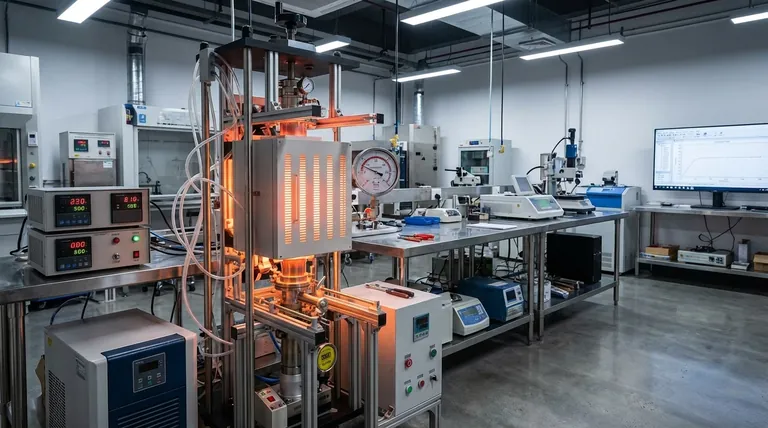In short, applying external pressure is a powerful accelerant for the sintering process. It physically forces material particles together, dramatically enhancing the rate and extent of densification, which reduces porosity and improves the final properties of the component.
The fundamental role of pressure in sintering is to overcome the natural barriers to densification. By mechanically forcing particles into intimate contact, it reduces the reliance on thermal energy alone, enabling faster processing at lower temperatures and achieving near-total elimination of internal pores.

The Fundamental Mechanism: How Pressure Drives Densification
Sintering is the process of turning a collection of loose particles—a "green body"—into a solid, dense object. This happens by heating the material below its melting point, causing atoms to diffuse across the boundaries of the particles, fusing them together.
Enhancing Particle-to-Particle Contact
At the microscopic level, sintering only occurs where particles touch. Without external force, these contact points are initially small and limited.
Applying pressure mechanically deforms the particles, vastly increasing the surface area at each contact point. This creates a much larger pathway for atomic diffusion to occur, accelerating the entire bonding process.
Aiding Particle Rearrangement
The initial packing of powder is often inefficient, leaving significant empty space (porosity). Pressure forces particles to slide and rearrange into a more tightly packed configuration.
This initial consolidation, known as particle rearrangement, is a critical first step in eliminating large pores before the diffusion bonding process even begins.
Eliminating Residual Porosity
As sintering progresses, pores shrink and become isolated. Removing these last remnants of porosity through diffusion alone is slow and difficult.
Pressure provides the final driving force needed to collapse these stubborn voids, which is essential for achieving the highest possible final density and superior mechanical properties.
Key Benefits of Applying Pressure During Sintering
Integrating pressure into the sintering cycle offers significant advantages over traditional, pressureless methods that rely solely on temperature and time.
Lower Sintering Temperatures
Because pressure provides a strong mechanical driving force for densification, you don't need as much thermal energy to achieve the same result.
This allows for significantly lower sintering temperatures, which is critical for materials that might degrade or undergo unwanted phase changes at higher heat.
Reduced Sintering Time
The combination of enhanced particle contact and rearrangement means the densification process happens much more quickly.
This can shorten the required "hold times" at peak temperature from many hours to, in some cases, just minutes, drastically improving process efficiency.
Understanding the Trade-offs and Considerations
While powerful, applying pressure is not a universal solution. It introduces complexities that must be managed.
Process Complexity and Cost
Pressure-assisted sintering techniques, such as Hot Pressing or Hot Isostatic Pressing (HIP), require specialized, high-cost equipment.
This contrasts with pressureless sintering, which can be done in a simpler furnace, making it more cost-effective for many applications.
Geometric Limitations
Applying pressure uniformly across a part with a complex geometry can be extremely challenging.
Non-uniform pressure can lead to density variations within the part, potentially causing internal stresses, warping, or other defects during or after the process.
Interaction with Other Parameters
Pressure does not work in isolation. Its effectiveness is deeply intertwined with temperature, particle size, and sintering atmosphere.
For example, applying high pressure without sufficient temperature will simply compact the powder without creating strong diffusion bonds. A reducing atmosphere might be needed to remove surface oxides that would otherwise inhibit bonding, even under pressure.
Making the Right Choice for Your Goal
The decision to use pressure depends entirely on the desired outcome for your final component.
- If your primary focus is cost-effectiveness for simple shapes: Pressureless sintering, which relies on optimizing temperature and time, is often the most practical approach.
- If your primary focus is achieving maximum density and superior mechanical properties: Pressure-assisted methods are essential for minimizing residual porosity and creating high-performance components.
- If your primary focus is processing temperature-sensitive or fine-grained materials: Applying pressure is a key strategy to achieve full densification at lower temperatures, preserving the material's microstructure.
Ultimately, leveraging pressure transforms sintering from a passive heating process into an actively controlled manufacturing method for engineering superior materials.
Summary Table:
| Effect of Pressure | Key Benefit |
|---|---|
| Enhanced Particle Contact | Accelerates atomic diffusion and bonding. |
| Particle Rearrangement | Eliminates large pores for tighter packing. |
| Eliminates Residual Porosity | Achieves near-theoretical density. |
| Lower Sintering Temperature | Protects temperature-sensitive materials. |
| Reduced Sintering Time | Increases process efficiency. |
Ready to enhance your sintering process with precise temperature and pressure control? KINTEK specializes in advanced lab furnaces and equipment for materials research and development. Our solutions help you achieve superior densification and material properties. Contact our experts today to discuss your specific application needs!
Visual Guide

Related Products
- Vacuum Hot Press Furnace Heated Vacuum Press Machine Tube Furnace
- Vacuum Hot Press Furnace Machine Heated Vacuum Press
- 600T Vacuum Induction Hot Press Furnace for Heat Treat and Sintering
- Vacuum Heat Treat Furnace with Ceramic Fiber Liner
- Vacuum Hot Press Furnace Machine for Lamination and Heating
People Also Ask
- What is pressure sintering? Achieve High-Density Materials Faster and Stronger
- What is the main function of hot press forming? Achieve Superior Strength & Precision in Manufacturing
- Is sintering the same as hot press? Unlock the Key Differences for Better Material Performance
- What is the process of hot-pressing sintering? Achieve Superior Density for High-Performance Materials
- What is pressure-assisted sintering? Achieve Denser, Stronger Materials Faster



















